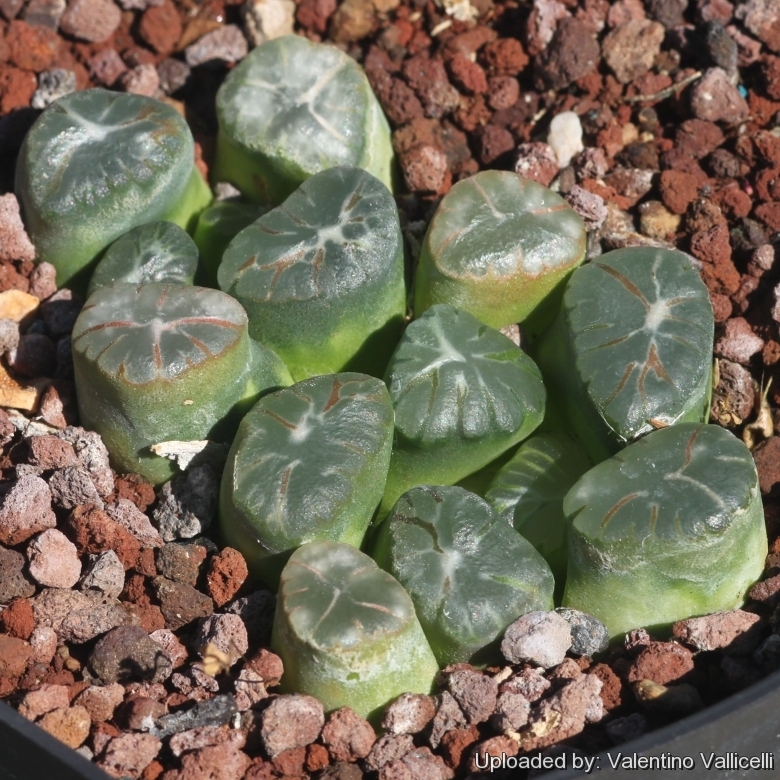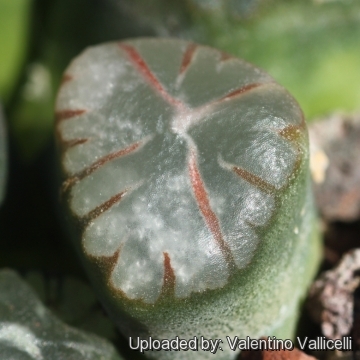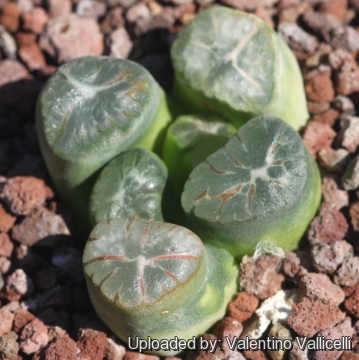
Haworthia truncata var. maughanii cv. Murasake Photo by: Valentino Vallicelli
Origin and Habitat: Japan (Nursery produced cultivar)
Synonyms:
See all synonyms of Haworthia truncata
Description: Haworthia truncataSN|11538]]SN|11538]] var. maughanii cv. Murasake is a beautiful cultivar with brick-red and white rayed design on the top. It is a superb, and very showy plant.
Habit: Stemless distichous plants, medium sized with windowed leaves on upper margin. Slowly clumping.
Leaves: The leaves look as if they have been roughly cut off at the tops and they are arranged like a fan, not a rosette. The surface is slightly warty and the blunt end is transparent whit interesting white and brick red starry leaf markings, this "lightning flash" patterns in the leaves do not come out until the plant reaches maturity.
Remarks: Haworthia truncataSN|11538]]SN|11538]] var. maughanii has been the subject of passionate work of breeding and selection by the Japanese, and a number of wonderful cultivars with different white or brownish-red lacy patterns on green-grey windowed tips have been developed and propagated, and some specimens have a very unique leaf shape.
Subspecies, varieties, forms and cultivars of plants belonging to the Haworthia truncata group
Bibliography: Major references and further lectures
1) M. B. Bayer “The new Haworthia handbook” National Botanic Gardens of South Africa, 1982
2) John Pilbeam “Haworthia and Astroloba: A Collector's Guide” 1983
3) Stuart Max Walters, James Cullen “The European Garden Flora: Pteridophyta, Gymnospermae, Angiospermae” Cambridge University Press, 1986
4) Gibbs Russell, G. E., W. G. Welman, E. Reitief, K. L. Immelman, G. Germishuizen, B. J. Pienaar, M. v. Wyk & A. Nicholas. "List of species of southern African plants.” Mem. Bot. Surv. S. Africa 1987
5) Ernst Van Jaarsveld, Ben-Erik Van Wyk, Gideon Smith “Succulents of South Africa: A Guide to the Regional Diversity” Tafelberg Publishers, Limited, 01/lug/2000
 Haworthia truncata var. maughanii cv. Murasake Photo by: Valentino Vallicelli
Haworthia truncata var. maughanii cv. Murasake Photo by: Valentino Vallicelli Haworthia truncata var. maughanii cv. Murasake Photo by: Valentino Vallicelli
Haworthia truncata var. maughanii cv. Murasake Photo by: Valentino Vallicelli Haworthia truncata var. maughanii cv. Murasake Photo by: Valentino Vallicelli
Haworthia truncata var. maughanii cv. Murasake Photo by: Valentino Vallicelli Haworthia truncata var. maughanii cv. Murasake Photo by: Valentino Vallicelli
Haworthia truncata var. maughanii cv. Murasake Photo by: Valentino VallicelliCultivation and Propagation: Not difficult to cultivate, though it is not fast growing and takes several years to form good looking heads. Haworthias are very responsive to differing cultural conditions both as regards colour, length and shape of leaves, rate of growth and size of plant.
Soil: It grows best in sandy-gritty soil and requires good drainage as it it is prone to root rot.
Fertilization: Feed it once or twice during the growing season with a fertilizer specifically formulated for cactus and succulents (poor in nitrogen), including all micro nutrients and trace elements diluted to ½ the strength recommended on the label.
Repotting: Must be repotted frequently, because every year a part of their roots die and then rots in the pot. Needs a deep pot to accommodate the long, thick, contractile roots.
Watering Needs: Water regularly in the growing season, but avoid water-logging and let dry between watering, they should never dry out completely during the rest period. If grown in a container, bottom watering by immersing the container is recommended. It must have very dry atmosphere.
Sun Exposure: Keep cool and shaded in summer, and provide locations with diffuse sunlight or light shade, it can tolerate shade, shelter from direct sun during the hottest hours. In shade the body colour will remain more green, while full sun will darken a lot. It can be sunburned if moved from shade/greenhouse into full sun too quickly. The amount of sunlight it can withstand without scorching depends upon the how hot it becomes in the summer in the locale in which it is planted. During the spring it may be able to take full sun until the heat arrives at the end of spring. In an area that has hot afternoon sun, it may be able to take full morning sun, but requires afternoon shade or afternoon light shade.
Frost Tolerance: Light frost protection required. It requires a minimum temperature of about 5°C (But will take a light frost and is hardy down to -5(-7)° C for short periods if it is in dry soil). USDA zones 9A – 11. In areas prone to frost, grow in an intermediate greenhouse or conservatory, in pots.
Pests and diseases: May be susceptible to mealybugs and rarely scale.
Propagation: Seeds, offsetts, leaves and roots cuttings. Leave the offsets that appear at the base between the leaves attached to form a cluster, or wait until they are 1/3 the size of the parent and then detach and plant. Cuttings root easily and remain true to the species, while seeds tend to hybridize.














